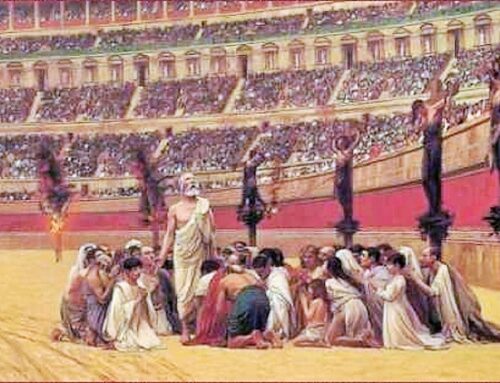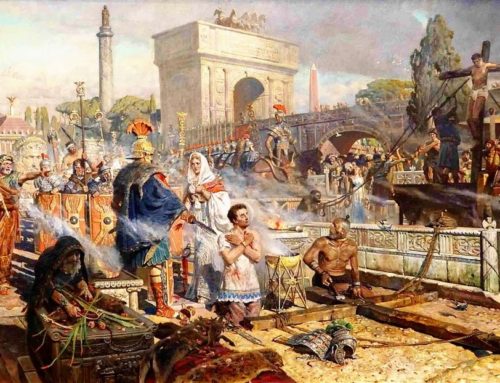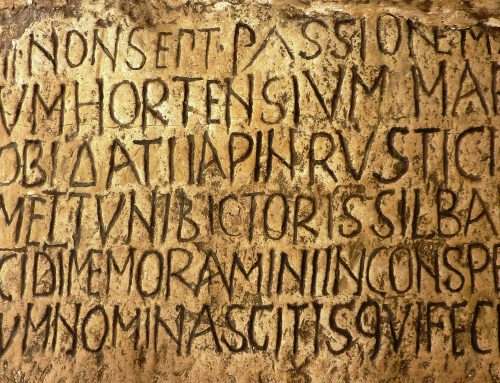The Church continues to make Christ present in human history. In the history of the Church, we find the divine and the human closely intertwined.
The Church continues to make Christ present in human history. In the history of the Church, we find the divine and the human closely intertwined.
In 476 the Roman Empire in the West fell, invaded by a series of Germanic people, some of whom were Arians and others pagans. The Church worked in the following centuries to evangelize and help civilize these people, and later on, the Slavs, Scandinavians and Magyars. The High Middle Ages (up to the year 1000) was undoubtedly a difficult period for Europe, marked by political and social upheaval, cultural impoverishment and economic regression, due to the continuous barbarian invasions, which lasted until the tenth century. The Church’s activity gradually helped lead these young peoples towards a new civilization that would reach its height between the twelfth and fourteenth centuries.
Benedictine monasticism, born in the sixth century, provided oases of peace, tranquility and culture in areas surrounding the monasteries. In the seventh century, Irish and Scottish monks carried out important missionary activity throughout all of Europe, as did the English Benedictines in the eighth century. In this century, the Patristic Age came to an end with the last of the Fathers of the Church, St. John Damascene in the East, and St. Bede the Venerable in the West.
At the end of the sixth century, the Islamic religion came to birth in Arabia. After Mohammed’s death, the Arabs set out on a wave of warfare and conquest that led to a vast empire. Among those subjugated were the Christian peoples of North Africa and the Iberian Peninsula. This helped bring about the separation of the Byzantine world from the Latin-Germanic world. For approximately 300 years, this state of affairs was a real scourge for the Mediterranean people of Europe, victims of the incursions, raids, plundering and deportations that went on systematically and unabatedly.
At the end of the eighth century, the temporal power of the papacy was formally established (the Papal States), which had already existed, in fact, since the end of the sixth century to fill the power vacuum in central Italy caused by the weakening of the Imperial Byzantine authority. The latter, nominally sovereign in the region, was incapable of providing the administration and defense the population required. Over time, the popes realized that a limited temporal power was an effective guarantee of independence with respect to the various political powers of the time (emperors, kings, feudal lords, etc.).
On Christmas Eve in the year 800, the empire was reestablished in the west (the Holy Roman Empire) with Charlemagne’s coronation by the pope in St. Peter’s Basilica. A Catholic state thereby came into being, with universal aspirations, characterized by a strong sacralization of political power, intertwining politics and religion, which would last until 1806.
In the tenth century, the papacy suffered a grave crisis resulting from the noble families of central Italy interfering in the election of the Pope; and, on a more widespread scale, kings and feudal lords claimed the authority to name the occupants of many ecclesiastical offices. Effective papal reaction to this situation awaited the 11th century Gregorian reform and the so-called “investiture controversy,” when the ecclesiastical hierarchy managed to recover a wide measure of freedom from the political powers.
In the year 1054, the patriarch de Constantinople, Michael Cerularius, brought about the final separation of the Greeks from the Catholic Church (the Eastern schism). This was the last episode in the history of disputes and ruptures that dated back to the fifth century, due in large part to the grave interferences by the Roman emperors of the East in the life of the Church (caesaro-papism). This schism affected all the people dependent on the Patriarchy, and even to this day it affects the Bulgars, Romanians, Ukrainians, Russians and Serbs.
At the beginning of the eleventh century, the Italian maritime republics had wrested control of the Mediterranean from the Moslems and restrained Islamic aggression. Towards the end of the century, the growth of military power in Christian countries took the form of crusades to the Holy Land (1096-1291). These were military expeditions of a religious nature whose aim was the recovery and defense of Jerusalem.
The twelfth and thirteenth centuries marked the zenith of medieval civilization, with the great theological and philosophical works of St. Albert the Great, St. Thomas Aquinas, St. Bonaventure, and Bl. Duns Scotus, along with other literary and artistic accomplishments. Of great importance for religious life was the appearance of the “mendicant” orders at the beginning of the thirteenth century, especially the Franciscans and Dominicans.
Confrontation between the papacy and the empire, already seen in the “investiture controversy,” continued unabated during the twelfth and thirteenth centuries, and only ended with the weakening of both institutions. The empire dwindled to a single Germanic state, while the papacy suffered a severe crisis. From the 1305 to 1377, the papal residence was transferred from Rome to Avignon in southern France. And soon after the pope’s return to Rome in the year 1378, the great Schism of the West began. This was a very difficult situation in which two popes appeared on the scene, and some years later, three (due to the different parties of cardinals gathered in conclave at Avignon, Rome, and Pisa). During all this upheaval, the Catholic people remained perplexed as to who was the legitimate pope. The Church only overcame this harsh trial when unity was finally restored with the election of a new pope at the Council of Constance (1415-1418).
In the year 1453, the Ottoman Turks conquered Constantinople, bringing to an end the thousand-year history of the Roman Empire of the East (395-1453); and they went on to conquer the Balkan people, who remained for four centuries under Muslim dominion.
OpusDei.uk





Leave A Comment
You must be logged in to post a comment.